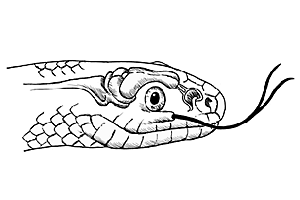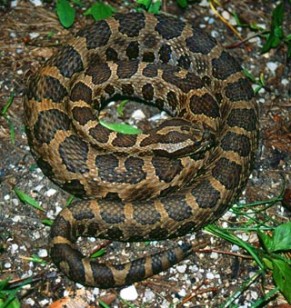How do Massasaugas Obtain Nutrients?
Massasaugas, like all organisms, need nutrients and energy to live and grow. To acquire these things, they must prey upon other animals. Massasauga rattlesnakes usually eat small mammals like mice or voles, small snakes, frogs, salamanders, and small birds when available.
 The first step massasaugas take is to locate their prey.
They flick out their tongue to pick up on different
scents in the area. Once they detect the
scent of a potential meal, they slither in that direction and
then rely on their thermal pits to help them visually locate
their prey. They rely on their camouflage to
keep them hidden from their prey while they are closing in for
the kill.
The first step massasaugas take is to locate their prey.
They flick out their tongue to pick up on different
scents in the area. Once they detect the
scent of a potential meal, they slither in that direction and
then rely on their thermal pits to help them visually locate
their prey. They rely on their camouflage to
keep them hidden from their prey while they are closing in for
the kill.
Then, massasaugas get within striking distance, which is about one third of their body length away. When they finally decide to strike, they do it very quickly and sink their fangs into the victim’s body. After they inject their venom through their fangs, they pull away from their prey to avoid being injured by the struggling animal. The animal might run away from the massasauga, but the snake knows that its prey is going to die and just follows it. When the animal stops wriggling, they eat it whole, since they can’t chew their food. They start to eat their prey from the head down.
 Here is a video from youtube that
actually shows a type of massasauga eating a mouse that is
already dead. You can see how it is using a plant for
shelter while it ingests the mouse. Click
here to see it. Don't watch it if that sounds really
disgusting. The meal is usually completely digested within a week.
The venom of the massasauga has an interesting double
function. Once it has been injected into the
prey and the prey dies, the venom starts to break down the
tissues from the inside to aid in the digestive process.
Here is a video from youtube that
actually shows a type of massasauga eating a mouse that is
already dead. You can see how it is using a plant for
shelter while it ingests the mouse. Click
here to see it. Don't watch it if that sounds really
disgusting. The meal is usually completely digested within a week.
The venom of the massasauga has an interesting double
function. Once it has been injected into the
prey and the prey dies, the venom starts to break down the
tissues from the inside to aid in the digestive process.
So that is how the massasauga gets its food. To find out more about its life cycle, click here!